WASHINGTON, George. Letter signed ("G o : Washington") to the "Gentlemen of the Senate , and of the House of Representatives," "United States," 13 December 1791. 1 page, 4to (7¾ x 8 1/16 in.), age-toned, small tear to lower corner carefully mended, left margin reinforced from verso . WASHINGTON FORMALLY LAYS BEFORE CONGRESS L'ENFANT'S PLAN OF THE NEW CAPITAL CITY WHICH WILL BEAR HIS NAME The letter, in a large, clear, secretarial script, reads: "Gentlemen of the Senate, and of the House of Representatives. I place before you the plan of a City that has been laid out within the District of ten miles square, which was fixed upon for the permanent seat of Government of the United States." After nearly seven year's wrangling over the selection of a site for the nation's new capital, a compromise was at last reached in 1790. The volatile debate, with pronounced sectional implications, pitted supporters of Hamilton and Jefferson against each other and delayed enactment of Hamilton's plan for the public credit, specifically, his controversial proposal for the Federal assumption of states' debt incurred during the war. Southern states, fearful of the growing power of the more populous Northern states, were anxious that the new capital be located along the Potomac rather than in a Northern manufacturing state. Finally Jefferson took on the role of mediator in the discussions between Madison and Hamilton and secured Southern delegates' agreement to support assumption in return for Northern votes to locate the capital on the Potomac. Both Assumption and Residence Bills became law in July; the latter authorized the President to appoint three Commissioners to assist in the selection of the exact site along the Potomac, "not exceeding ten miles square." His choice fell upon Daniel Carroll and Thomas Johnson of Maryland and David Stuart of Virginia. The President was very familiar with the area, and in January 1791 had specified that exact boundaries of "the Territory of Columbia." He also appointed an experienced surveyor, Andrew Ellicott to lay out the boundaries and, later, streets and lots. But Washington's most significant appointment was that of Pierre Charles L'Enfant as designer of the capital. A French-trained engineer who had served in the American Revolution, L'Enfant had discussed the idea of the new capital with Washington for several years, and in 1789 voiced his enthusiasm: "No nation had ever before the opportunity offered them of deciding on the spot where their Capital City should be fixed, or of combining every necessary consideration in the choice of situation..." Before starting work he borrowed engravings and plans of major European cities from Jefferson's library, and studied a rough proposed layout drawn by Jefferson himself. In June, he visited Washington at Mount Vernon to show the President a draft of his plan, and in August traveled to Philadelphia to lay before the President the finished plan for the city, executed in ink and watercolor and justly regarded as a masterpiece of civic design (now in the Geography and Map Division, Library of Congress). The two focal points of L'Enfant's proposal--the President's House and the Capitol--were to be connected by a 400-foot wide mall, while a radial grid of broad boulevards, affording interesting views and connecting key buildings, was superimposed over the standard rectilinear grid of streets. Here, Washington formally introduces the members of the Second Congress and the American people to the vision of the city that would bear his name and would serve as the new nation's capital. While the plan was almost uniformly praised, translating L'Enfant's highly original vision into a reality of bricks and paving-stones would require decades. The obtuse and uncooperative architect himself, after a series of confrontations with the Commissioners, Jefferson and the President, was finally dismissed in February 1792 (see Washington's letter to Stuart, the preceding lot, for
WASHINGTON, George. Letter signed ("G o : Washington") to the "Gentlemen of the Senate , and of the House of Representatives," "United States," 13 December 1791. 1 page, 4to (7¾ x 8 1/16 in.), age-toned, small tear to lower corner carefully mended, left margin reinforced from verso . WASHINGTON FORMALLY LAYS BEFORE CONGRESS L'ENFANT'S PLAN OF THE NEW CAPITAL CITY WHICH WILL BEAR HIS NAME The letter, in a large, clear, secretarial script, reads: "Gentlemen of the Senate, and of the House of Representatives. I place before you the plan of a City that has been laid out within the District of ten miles square, which was fixed upon for the permanent seat of Government of the United States." After nearly seven year's wrangling over the selection of a site for the nation's new capital, a compromise was at last reached in 1790. The volatile debate, with pronounced sectional implications, pitted supporters of Hamilton and Jefferson against each other and delayed enactment of Hamilton's plan for the public credit, specifically, his controversial proposal for the Federal assumption of states' debt incurred during the war. Southern states, fearful of the growing power of the more populous Northern states, were anxious that the new capital be located along the Potomac rather than in a Northern manufacturing state. Finally Jefferson took on the role of mediator in the discussions between Madison and Hamilton and secured Southern delegates' agreement to support assumption in return for Northern votes to locate the capital on the Potomac. Both Assumption and Residence Bills became law in July; the latter authorized the President to appoint three Commissioners to assist in the selection of the exact site along the Potomac, "not exceeding ten miles square." His choice fell upon Daniel Carroll and Thomas Johnson of Maryland and David Stuart of Virginia. The President was very familiar with the area, and in January 1791 had specified that exact boundaries of "the Territory of Columbia." He also appointed an experienced surveyor, Andrew Ellicott to lay out the boundaries and, later, streets and lots. But Washington's most significant appointment was that of Pierre Charles L'Enfant as designer of the capital. A French-trained engineer who had served in the American Revolution, L'Enfant had discussed the idea of the new capital with Washington for several years, and in 1789 voiced his enthusiasm: "No nation had ever before the opportunity offered them of deciding on the spot where their Capital City should be fixed, or of combining every necessary consideration in the choice of situation..." Before starting work he borrowed engravings and plans of major European cities from Jefferson's library, and studied a rough proposed layout drawn by Jefferson himself. In June, he visited Washington at Mount Vernon to show the President a draft of his plan, and in August traveled to Philadelphia to lay before the President the finished plan for the city, executed in ink and watercolor and justly regarded as a masterpiece of civic design (now in the Geography and Map Division, Library of Congress). The two focal points of L'Enfant's proposal--the President's House and the Capitol--were to be connected by a 400-foot wide mall, while a radial grid of broad boulevards, affording interesting views and connecting key buildings, was superimposed over the standard rectilinear grid of streets. Here, Washington formally introduces the members of the Second Congress and the American people to the vision of the city that would bear his name and would serve as the new nation's capital. While the plan was almost uniformly praised, translating L'Enfant's highly original vision into a reality of bricks and paving-stones would require decades. The obtuse and uncooperative architect himself, after a series of confrontations with the Commissioners, Jefferson and the President, was finally dismissed in February 1792 (see Washington's letter to Stuart, the preceding lot, for
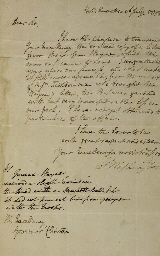

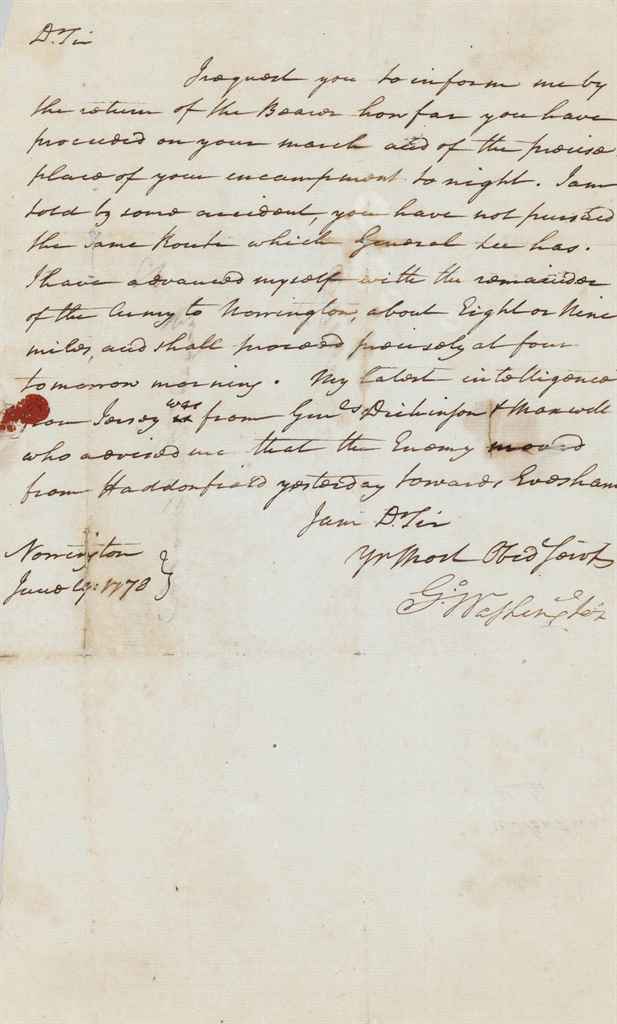
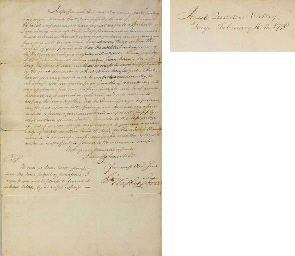
.jpg)
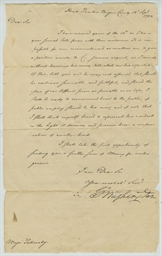
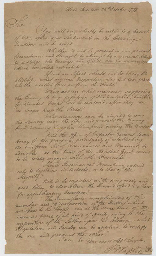
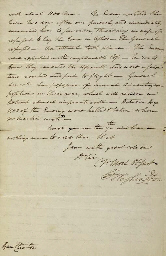
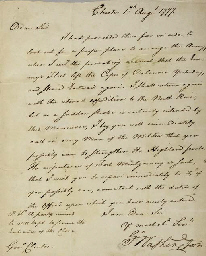
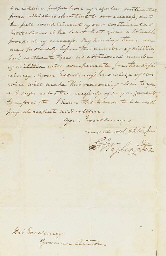
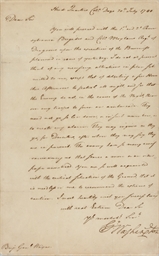


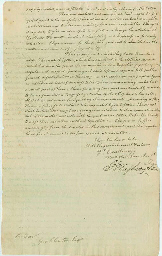
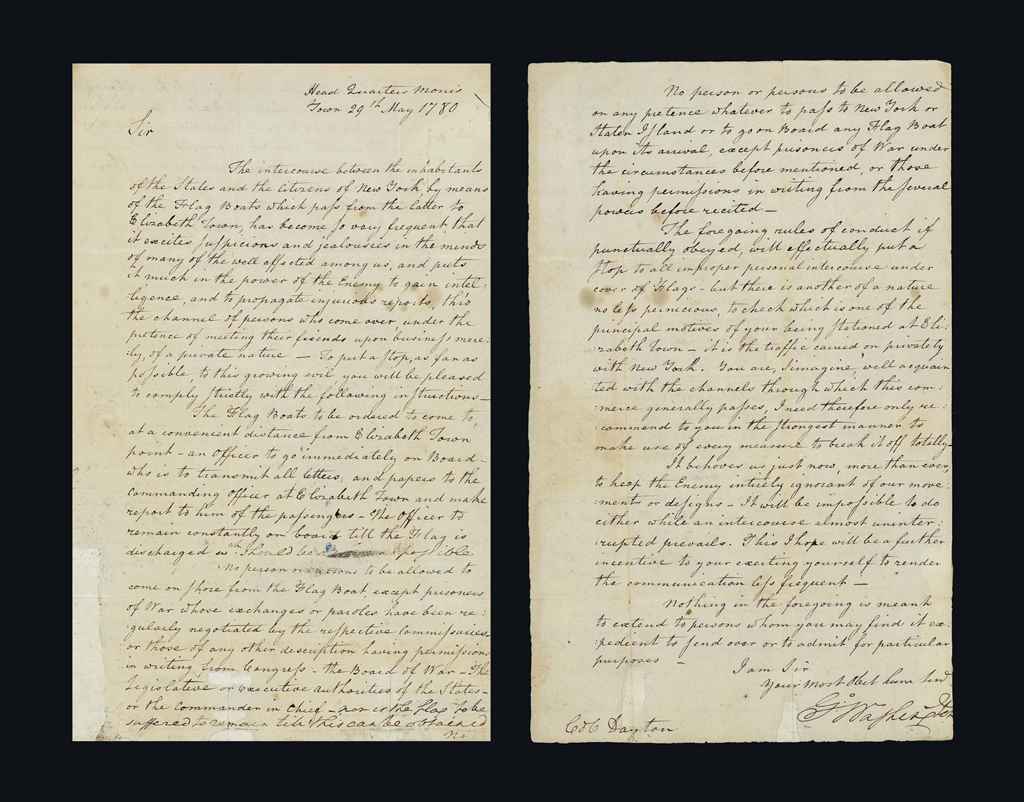
Testen Sie LotSearch und seine Premium-Features 7 Tage - ohne Kosten!
Lassen Sie sich automatisch über neue Objekte in kommenden Auktionen benachrichtigen.
Suchauftrag anlegen